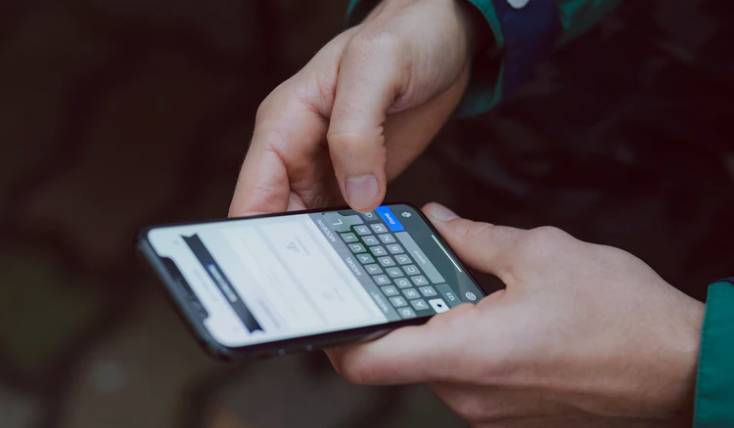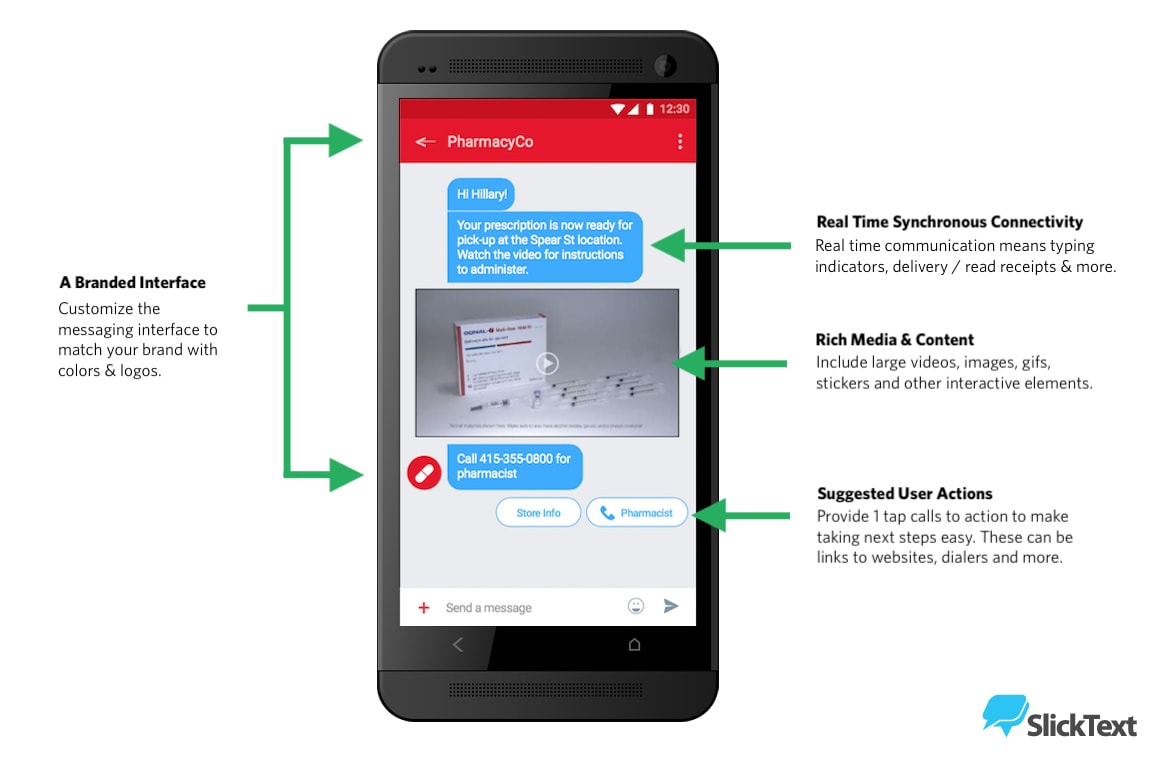What Is RCS Messaging and How Does It Work?

Updated March 4th, 2025
RCS (Rich Communication Services) messaging is a messaging protocol that’s designed to replace SMS. It allows messaging interactions like read receipts and tapback responses that are popular in iMessage, even if the messaging takes place between an iPhone user and an Android user.
RCS enhances daily messaging activities and is the messaging protocol for the smartphone era, taking features you’re probably familiar with from apps like Facebook Messenger or WhatsApp and turning them into everyday standards. If your iPhone is updated to iOS18, RCS should already be active on your phone. If not, iPhone users may need to flip a toggle in Settings or update their phone software. Android users should navigate to Google Messages, tap their profile picture or icon to go to Message Settings, and then tap RCS chats to enable RCS.
Here’s what RCS messaging is and how it will impact your mass texting strategy.
What is RCS messaging?
RCS stands for “Rich Communication Services” and experts predict it will replace SMS in the near future. Think of it as an evolution of text messaging. It incorporates many of the features of popular messaging apps like iMessage or WeChat while still operating on a telecom network.
What is RCS chat? This is a synonym for RCS messaging, and the terms are used interchangeably. There are some differences between RCS and SMS, though.
RCS vs SMS: What’s the difference?
RCS messaging is like a next-generation SMS. There are a few key upgrades to note when comparing RCS vs SMS.
Take a look at this side-by-side chart comparison of SMS vs RCS to see what the difference is.
| Capabilities | RCS | SMS |
| Uses a data connection | Yes | Yes |
| Send read receipts or see what friends are typing | Yes | No |
| Send files | Yes, up to 100MB | No |
| Character limit | No | Yes, 160 characters |
What’s so special about RCS compared to SMS? Here are a few applications of the new technology:
- You can send read receipts and see when your friends are typing.
- Yo can send files directly through RCS. Like an enhanced version of MMS marketing, imagine getting your airline tickets or choosing concert seats directly from an RCS message.
- It’s easier to send multimedia elements such as GIFs or stickers.
- Group messages are streamlined, with more personalization options.
These are many of the features that smartphone users are familiar within their messaging apps, but with RCS you’ll be able to have this user experience when messaging anyone, regardless of the phone’s operating system.
When will you get RCS?
When can you use RCS messaging in the United States?
Currently, most major U.S. carriers including Verizon, AT&T, and T-Mobile support RCS, but some smaller providers may not. In 2025, nearly every T-Mobile Android comes with RCS Universal Profile 1.0 automatically built into the phone’s messaging app.
You can use RCS messaging when:
- Your carrier supports RCS, which is highly likely if you get service from Verizon, AT&T, or T-Mobile.
- You Have an RCS-Compatible Phone, which includes Android 5.0 or later, iPhones with iOS18 or later, Pixel 3, and Pixel 3XL.
- You use Google Messages, Samsung Messages, or another supported messaging app.
- Both you and the recipient have RCS enabled—even if you are using two different operating systems. If one person is only using SMS, the message will fall back to regular texting.
- You have mobile data or an active internet connection to send and receive messages.
RCS statistics show that un-carrier customers globally send more than 700 million RCS messages daily. This is meaningful progress in promoting RCS adoption.
History of implementing RCS
It wasn’t until 2016 that many U.S. carriers began supporting RCS. T-Mobile was the first carrier to launch RCS messaging in the United States, followed by Verizon, AT&T, and Sprint.
In 2016, the GSM Association, which is the trade body representing mobile operators, agreed to what they call a “Universal Profile” to aid the rollout of RCS. The Universal Profile is:
“A single, industry-agreed set of features and technical enablers developed to simplify the product development and global operator deployment of RCS.”
Cross-Carrier Messaging Initiative
To roll out RCS messaging in the United States, the “Big Four” networks — Verizon, AT&T, T-Mobile, and Sprint — formed a joint venture dubbed the Cross Carrier Messaging Initiative (CCMI) and announced in a joint press release in October 2019. These are the goals of the CCMI:
- Create more opportunities for meaningful business-to-consumer messaging. (This is great news for marketers and those who use mass text messaging as a marketing and communications technique, as we’ll expand upon below).
- Make it easier to send high-quality photos and videos privately via individual or group chat.
- Allow consumers the ability to interact with their favorite brands or take actions related to their favorite brands directly from their messaging app. These actions could be anything from ordering food or a ride share to paying bills, reserving a table, or confirming an appointment.
How to enable RCS messaging on Android
To enable RCS messaging, Android users should do the following:
- Navigate to Google Messages on your phone.
- Tap your profile picture or icon and then open Message Settings.
- Tap RCS chats.
- Turn on RCS chats to enable RCS messaging.
If for some reason you don’t see the option to turn on RSC chats, Google recommends troubleshooting by tapping “Chat Features” and then “Verify Your Number.”
You can also turn off RCS messaging on an Android by following the steps above.
How to enable RCS messaging on iPhone
In September 2024, Apple released iOS18, which introduced RCS messaging support for your iphone. To make sure RCS is enabled, iPhone users should do the following:
- Navigate to Settings on your iPhone.
- Scroll down and select Apps at the bottom of the screen.
- Select Messages from the available Apps.
- Scroll down until you see the Text Messaging section, with RCS Messaging listed at the top of the category.
- Click on RCS Messaging. On the next screen, if the toggle is green, RCS is enabled on your phone. If not, you can simply flip the toggle to turn on RCS Messaging on your phone.
If you don’t see these options on your iPhone, it may be time to update your phone software.
You can also turn off RCS messaging on an iPhone by following the steps above.
How can RCS messaging help marketers?
RCS messaging could provide a powerful tool for businesses looking to engage with their audience like never before. It has the potential to extend the bounds of creativity in your marketing campaigns and could streamline your efforts to connect with your clients.
Here are a few of the ways RCS messaging can improve the relationship between brands and their clients.
Easy to verify
Nothing disintegrates trust between your business and your audience faster than coming across as spammy. RCS messaging enables sender verification so your clients can easily recognize your number.
Send real-time updates
RCS messaging will allow companies to send automatic text messages on order statuses, boarding passes, seat selections, and upcoming appointments. Plus, you’ll be able to do all of this using multimedia to enhance your message. In this instance, it’s similar to MMS but a lot more flexible. You can send GIFs, videos, and loyalty cards directly through an RCS message.
Maximize flexible content options
Because RCS messaging doesn’t have the standard 160-character limit that SMS messaging does, you can write longer messages to your clients. Instead of skimping on words and finding abbreviations, you’ll have some leeway to inject your brand’s voice into the message. Plus, you can add special touches like audio, video, stickers, or high-resolution photos. You’ll be able to send PDFs, display product carousels, add calendars for scheduling, and, best of all, suggest a direct call-to-action that customers can immediately take.
Streamline your call-to-action
Nowadays, if a user wants to call your company or click on your website, they have to open their web browser or leave their messaging app. With RCS messaging, they’ll be able to click a button from the text message itself to call you or access certain elements of your website directly from the message.
This creates less friction in the call-to-action process which is likely to have the impact of creating more conversions. Essentially, you’ll lose fewer people along the way.

How does RCS impact SlickText?
At SlickText, we love new technology. We’re always looking out for the next great thing that we can offer as part of our business text messaging services. We’ve already rolled out new features in our platform that allow you to take advantage of this new method of communicating with your customers.